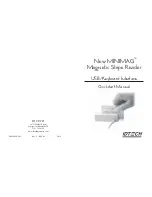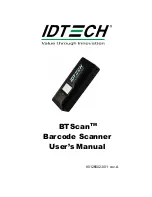
6
V550-A20 Operation Manual
Glossary
6
When data is transmitted serially from a communications port, the
information is transferred between the two devices one data bit at
a time. The data flow can follow one of three different communica-
tions modes: simplex, half duplex, or full duplex. Each character
of data within the data flow is transported in a binary bit frame
called the asynchronous data frame.
The start bit begins each frame. A low voltage signal on the data
communications line marks the beginning of the start bit, at which
point the receiving device begins looking for binary zeros and
ones (0’s and 1’s).
The following five to eight data bits (the number depends on the
format used) comprise the binary character.
For error detection, an optional parity bit can define whether the
total number of zeros or ones was even or odd. There are five
different parity selections as shown below:
ODD
- last data bit is a logical 0 if the total number of logical 1’s in
the first seven data bits is odd.
EVEN
- last data bit is a logical 0 if the total number of logical 1’s
in the first seven data bits is even.
MARK
- last data bit is always a logical 1 (i.e.: high/mark).
SPACE
- last data bit is always a logical 0 (i.e.: low/space).
OFF (NONE)
- last data bit is not present.
The method used to catch errors by using parity bits is as follows:
When the transmitter frames a character, it tallies the number of
0’s and 1’s within the frame and attaches a parity bit. (The parity
bit varies according to whether the total is even or odd.) The
receiving end then counts the 0’s and 1’s and compares the total
to the odd or even recorded by the parity bit. If a discrepancy is
noticed by the receiving end, it can flag the error and request a
retransmission of the data.
A stop bit is used to signal the end of the character. (Stop bits are
typically one or two bits in length. The slower the transmission
speed, the more stop bits required for recognition of the end of
the data frame.)
In addition to the direction of data flow and the data framing, there
are other considerations to insure uniform transmissions. Certain
operating parameters must be followed to prevent the loss of
valuable data.
The first consideration is the speed of transmission, known as
baud rate. Serial data transmission is measured in bits per
second (BPS). The baud rate selections available for the V550-
A20 are: 300, 600, 1200, 2400, 4800, 9600, 19200, 38400, and
57600. To enable two devices to interact, they must both be
transmitting/receiving data at the same baud rate. If it is not
possible to do this, there must be a buffer (typically additional
storage memory) that accommodates the differences in communi-
cations speed.
Many serial communications links also use a flow control system
to handle data transmission in addition to memory buffers.
X-ON/X-OFF Protocol
A common type of flow control is the X-ON/X-OFF protocol. When
a receive buffer nears its memory capacity, the receiving device
sends an ASCII X-OFF signal to the transmitting device, telling it
to stop sending data. When the memory buffer has enough space
to handle more data, the X-ON signal is sent to the transmitting
device, telling it to start sending data again.
ACK/NAK Protocol
Another common protocol is ACK/NAK protocol. When the device
transmits a message to the host, the host responds with either an
ACK (06H) or a NAK (15H). If the host transmits an ACK to the
device, the device deletes its transmit message and the communi-
cation sequence is complete. If the host transmits a NAK, the
device will retransmit. The device resends data a maximum of
three times. Optionally this may be changed to 1, 2, 3, or infinite
retransmits by the user. If the device receives a fourth NAK, it will
delete the data in its transmit buffer and display “MAX REXMITS”.
A transmitting device ignores ACK and NAK characters received
during data transmission. If, for example, a device receives a NAK
during a data transmission, it will not resend the data at the
completion of the transmission.
The device also has a retransmit timer. This timer is activated
each time the device transmits data to the host. If the timer runs
for two seconds (this is also changeable) and the device does not
receive an ACK or NAK from the host, a timeout occurs and the
device retransmits its data. Each time the device retransmits
because of a timeout, it treats the timeout the same as receiving a
NAK from the host computer. If the device does not receive an
ACK before the end of the fourth timeout, it will delete the data in
its transmit buffer and display “MAX REXMITS”. The device
deletes data in its transmit buffer and displays the error message
when any combination of four timeouts and NAKs from the host
occurs.
When the device receives a message from the host, it calculates
the BCC for the message and compares the calculated BCC to
the received BCC. If the two values match, the device transmits
an ACK, ending the communication. If the values do not match,
the device transmits a NAK to the host and waits for the host to
retransmit the message. The host, like the device, should
retransmit a maximum of three times.
The sequence number starts at zero (30H) and is incremented
each time a device transmits a new message. When the
sequence number reaches nine (39H), it wraps around to one
(31H). If the sequence number skips a number, the receiving
device knows that a message was lost. If the same sequence
number is received on two sequential messages, the second
message is responded to with an ACK or NAK (as appropriate)
and ignored.
Shielding
- Protective covering that eliminates electromagnetic
and radio frequency interference.
Side Read -
The scanner is mounted to read the side of a box as
it passes by the head.
Signal
- An impulse or fluctuating electrical quantity (i.e.: a
voltage or current) the variations of which represent changes in
information.
Skew
- Rotation about the Y-axis. Rotational deviation from
correct horizontal and vertical orientation; may apply to single
character, line or entire encoded item.
Содержание V550-A20
Страница 1: ...i V550 A20 Operation Manual V550 A20 Bar Code Reader Operation Manual Cat No Q01BAZ2...
Страница 5: ......
Страница 6: ......
Страница 7: ......
Страница 8: ......
Страница 9: ......
Страница 10: ......
Страница 11: ......
Страница 12: ......
Страница 13: ......
Страница 14: ......
Страница 26: ...12 V550 A20 Operation Manual Section 2 12 What to Do After Receiving the V550 A20...
Страница 59: ......
Страница 66: ...18 V550 A20 Operation Manual Section 5 18 Appendices...
Страница 74: ...8 V550 A20 Operation Manual Glossary 8...
Страница 76: ...2 V550 A20 Operation Manual INDEX 2...





































